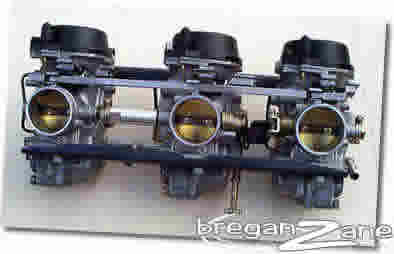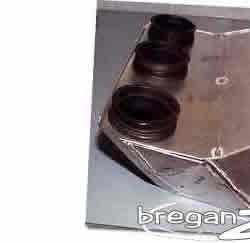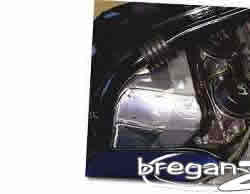CARBURETTORS - MIKUNI OR KEIHIN CV
One option to improve your carburation is to adapt Mikuni or Keihin CV carbs as fitted to most motorcycle engines from the mid 1980's to the early 2000's. This is the path that I took more than 10 years ago, based on a carb rack from a 1989 GSXR1100. It is not the path to take for outright performance, but the CV type of carb offers many advantages for the street rider. They generally have a semi-flat slide but do not confuse this type of carb with real "flatslides". Probably the best source of these carbs for the Laverda rider is from the first series of "big block" Hinkley Triumphs, which are already in a bank of three, though they need to be re-spaced.MIKUNI CV CARBS FOR THE TRIPLE
(Written January 2001)
The venerable old Dell'Ortos, though they were fine in their day, are showing their age now. There are a number of newer carbs that will improve the performance of your Laverda depending on what you desire. If you really want to get serious, the best carb available is the Keihin FCR flatslide. These are a truly wonderful piece of gear but are very race-focused with no chokes, a very heavy throttle action and a v-e-r-y high price.
 JULY
2000- I wanted something better than the Dell'Ortos for my RGA, so armed
with the knowledge that modern bikes all seem to use CV's and have little
trouble making good hp I wandered down to my local wrecker and came home
with a set of 36mm Mikuni CV Flatslides sourced from a 1989 GSXR1100 for
the happy sum of $150. Putting CV's on a Laverda is nothing new with
a fellow here in Canberra running a set of Suzuki Kettle (GT750 2-stroke)
carbs way back in the early 80's and a Canadian fellow by the name of
Gerry Nagy having used a set similar to these on his RGS. Many thanks
must go to Wolfgang Haerter for putting me onto Gerry who was a great
help in the initial stages of the project.
JULY
2000- I wanted something better than the Dell'Ortos for my RGA, so armed
with the knowledge that modern bikes all seem to use CV's and have little
trouble making good hp I wandered down to my local wrecker and came home
with a set of 36mm Mikuni CV Flatslides sourced from a 1989 GSXR1100 for
the happy sum of $150. Putting CV's on a Laverda is nothing new with
a fellow here in Canberra running a set of Suzuki Kettle (GT750 2-stroke)
carbs way back in the early 80's and a Canadian fellow by the name of
Gerry Nagy having used a set similar to these on his RGS. Many thanks
must go to Wolfgang Haerter for putting me onto Gerry who was a great
help in the initial stages of the project.
The first step was to pull them apart and see how they worked. What strikes you after the Dell'Ortos is how small and light they are and when you take them apart you see why - there's nothing to them! The first thing to do was decide which carb to ditch from the original rack of four and I elected to remove the left side one as it seemed to make the linkages easiest to set up. Second job was to re-space the carbs to the correct centre distance for the Laverda, with a new pair of spacer plates fabricated for the job.
 September
2000- As the spacing had changed radically from the original Suzuki
setup (whose cylinders are much closer together), the butterfly actuators
had to be linked together again. This was achieved with a little welding
onto the original tab and a small extension shaft for the other. Fuel
manifolds were now also incorrect so a tee was made to fit between #2
and #3 and an elbow type connection for #1 which will require a clip to
retain it at some later date. Plain sailing so far...
September
2000- As the spacing had changed radically from the original Suzuki
setup (whose cylinders are much closer together), the butterfly actuators
had to be linked together again. This was achieved with a little welding
onto the original tab and a small extension shaft for the other. Fuel
manifolds were now also incorrect so a tee was made to fit between #2
and #3 and an elbow type connection for #1 which will require a clip to
retain it at some later date. Plain sailing so far...
Next on the list is the chokes which are opened by a flat shaft running across the top of the bank. After trying to cut and re-weld the original I threw the resulting mess away and made a new one from scratch - a flat shaft with welded-on tags to actuate the chokes. All that remains to do is make a tab onto which the cable nipple can attach.
November 2000- And so it was time to fit them to the bike. After fruitlessly scrounging the wreckers for inlet rubbers, I had noticed that modern Triumphs run the same carbs and have a nice female-female inlet rubber with a slight downward kink. This is important as I was already realising how tight the clearance under the RGS tank would be - even though these carbs are much smaller they are a bit wider especially at the top. A call to the Triumph dealer had them on my doorstep a few days later and by pure luck the engine side connection is very close to that of a Laverda and only minor modifications were required for a satisfactory fit, although ideally the stubs should be a little bigger - a job for later perhaps...
Cables were subsequently made up to suit and the bike was fired up for the first time. Initial indications were good, so work began on the airbox. From the outset I wanted to make an airbox but needed some nice connection onto the inlet side of the carb. Once again the wrecker had the answer in the form of a nice inlet rubber which fitted the oval carb throat beautifully and also had a nice velocity stack-type profile and a nice looking ridge that would push into a sheetmetal airbox to form a seal. I am no sheetmetal master-craftsman, so it was a matter of a lot of cutting and welding, fiddling, filing and measuring. It's a tight fit but it worked in the end.
 |
 |
 |
 |
With the airbox installed the bike was immediately rideable, obviously being a reasonable match to the airflow of the original GSXR. A little bit of fiddling with needles and main jets and the bike was starting and running smooth and strong throughout the rev range. Top end power was probably a little down on the Dell'Ortos, but the midrange more than made up for it. It is now effortless to ride on a twisting road, grunting out of corners where before it had nothing. The thing is so tractable you would not believe it, the combination of 1130 JE pistons, Axtell cams, IIS ignition and the carbs are a killer!

